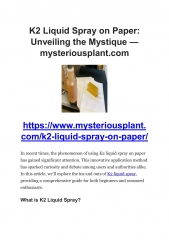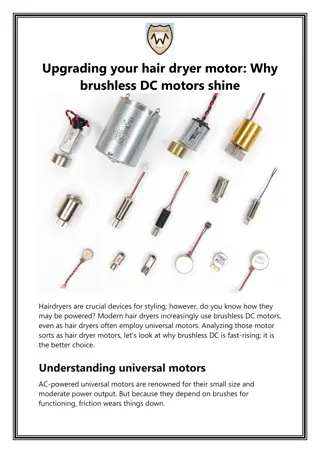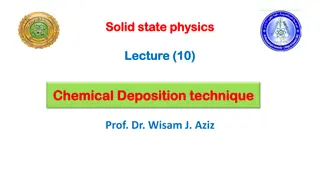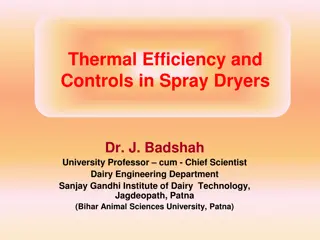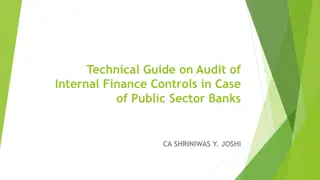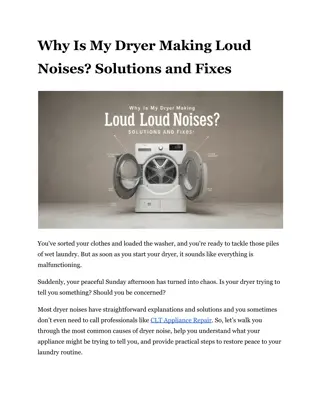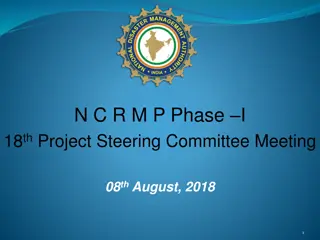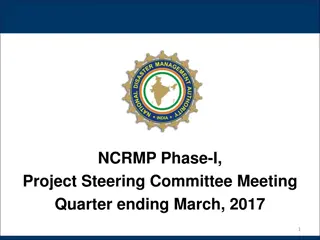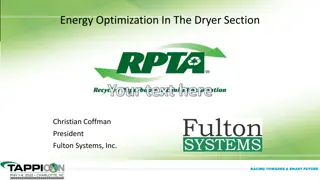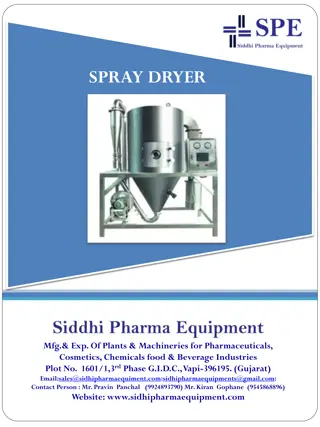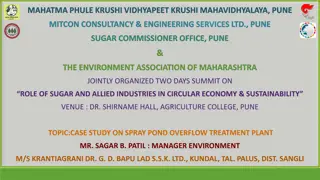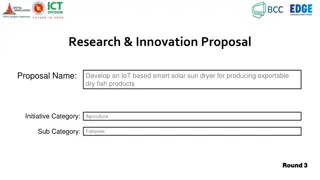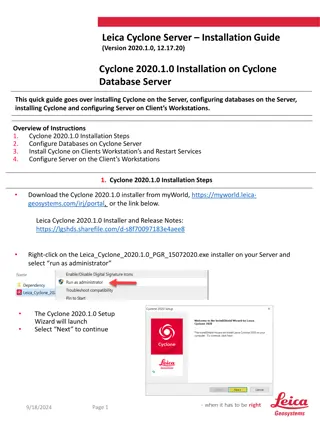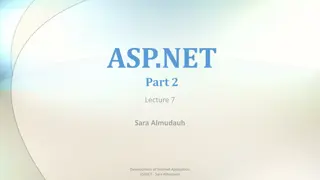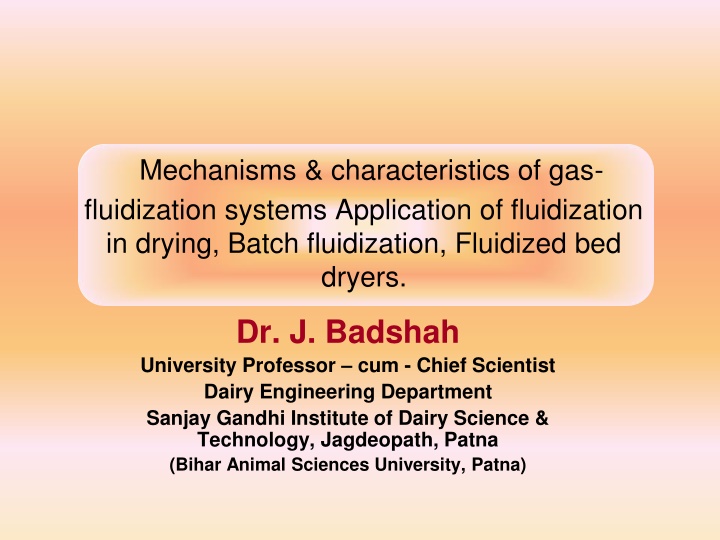
Gas-Fluidization and Cyclone Separators Efficiency Insights
Understand the mechanisms and characteristics of gas-fluidization systems, the application of fluidization in drying, batch fluidization, and fluidized bed dryers. Explore solid-gas separation in spray dryers, the importance of separating fine powder particles, and methods of powder recovery from exhaust air using cyclone separators, bag filters, and wet scrubbers. Learn about the efficiency of cyclone separators, including factors affecting optimum size, mass, tangential velocity, and radial distance of particles. Discover terms defining cyclone efficiency and the significance of particle size distribution. Dr. J. Badshah provides valuable insights into these topics.
Download Presentation

Please find below an Image/Link to download the presentation.
The content on the website is provided AS IS for your information and personal use only. It may not be sold, licensed, or shared on other websites without obtaining consent from the author. If you encounter any issues during the download, it is possible that the publisher has removed the file from their server.
You are allowed to download the files provided on this website for personal or commercial use, subject to the condition that they are used lawfully. All files are the property of their respective owners.
The content on the website is provided AS IS for your information and personal use only. It may not be sold, licensed, or shared on other websites without obtaining consent from the author.
E N D
Presentation Transcript
Mechanisms & characteristics of gas- fluidization systems Application of fluidization in drying, Batch fluidization, Fluidized bed dryers. Dr. J. Badshah University Professor cum - Chief Scientist Dairy Engineering Department Sanjay Gandhi Institute of Dairy Science & Technology, Jagdeopath, Patna (Bihar Animal Sciences University, Patna)
Solid Gas Separation in spray Dryers Importance of Separation of fine powder particles (10 -30%) from air exiting from drying chamber Economic Reasons Pollution Problems Methods of powder recovery from exhaust air 1. Cyclone separators 2. Bag filters 3. Wet scrubbers Working of Cyclone Separators High efficiency, Easy to maintain and Easy to clean. Vortex motion due to centrifugal force move the particles of powder towards the wall but the Drag force of the air tries to carry the particles towards axis of cyclone. Centrifugal force predominant over drag force resulted in separation of particles towards radial direction. Powder leaves the bottom of the cyclone via a locking device. The clean air spirals upwards along the center axis of the cyclone and passes out at the top.
Efficiency of Cyclone separators Optimum size and Nos. of cyclone depend upon: Centrifugal Force = m ( vt)2/ r Higher mass, Higher tangential velocity and lower radial distance of particles i.e. conical shape towards exit of powder particles results in high efficiency of separation. Residence time should be equal to the time required by the towards wall for smallest size of particles Risk of air leaks through valves in multi-cyclones Need of one valve , final cyclone and central hopper Same pressure drop over each cyclone to avoid powder losses Cleaning problems and large nos. of corners and crevices for bacterial growing and multiplying problem Optimum size is not 1.0 meter dia. Of cyclone but generally 2.5 -3.0 m dia. With air handling cap. Of 25,000 to 30,000 kg/hr. travel
Efficiency of Cyclone separators Cyclone diameter : Inlet duct diameter = 3:1 Cyclone diameter : exit duct diameter = 10:1 Air through-put velocity V0and increased pressure drops will also increase the efficiency, but the energy requirement will increase simultaneously. In general the upper limit of pressure drop is 175-200 mm WG for skimmilk powder and 140-160 mm WG is the maximum for whole milk in order to avoid deposits and final blocking. In most cases rotary valves are used as air lock and product discharge at the bottom of the cyclone
Terms to define efficiency of cyclone The critical particle diameter : The particle size that will be completely removed from the air flow (100% collection efficiency). The cut size : The size for which 50% collection is obtained The overall cyclone efficiency : It is obtained when handling a product of definite size distribution. Another method of learning the cyclone efficiency is by a simple powder loss measurement after the cyclone. A very small fraction of the out-going air is passed through a high- efficient mini cyclone or through micro dust filters.
Bag Filters Stack Losses Requirement: Less than 0.5 % to make ecofriendly Bag Filters of proper fabrics material may give high efficiency with collection of particles of 1 micron size even. Fabrics filters consist of woven fabrics of tubular shape and supported over certain frames preferable. Arrangement of multi bag filters to have equal volume of air through each filter from outside to inside Clean air is exhausted from inner part of bags to exhaust manifolds and powder The collected powder is automatically compressed air through the filter bags from the inner side. The powder is collected at the bottom via a rotary valve. Continuous build up dust layer on the fabric surface results in increase in pressure drop and thus in drop of capacity. To avoid this, the dust is continuously dislodged by mechanical sacking or by reverse air pulsations. shaken off by blowing
Bag Filters.. Contd. Collection efficiency : 99 % for particles upto 1 micron Pressure Drop : 7- 15 cm of water gauge Dry Recovery is advantageous in comparison to wet scrubbers No corrosion and rusting Plugging of fabric pores replacement due to hygrscopicity of powder The amount of powder collected is directly proportional to the powder loss, which will mainly due to: Feed with low solids or feed containing air High outlet air temperature Low particle density due to entrapment of air Leaking product outlet from old non-adjusted rotary valves Blocked cyclone Change in drying parameter resulting in decrease of mean particle size need maintenance and frequent
Wet Scrubbers Working of wet scrubber: It is based on the venturi scrubber principle with an efficiency very close to 100%. The liquid is injected through full - cone nozzles in the ventury as driving fluid and the outlet air from the spray dryer containing powder particles is accelerated to a high velocity in the venturi inlet before mixing zone. Due to different velocities between the air/particles and the liquid droplets, they will collide, mixed and the powder will dissolve in the liquid droplets. Passing through the subsequent diffuser this process will continue simultaneously with a certain pressure recovery of the air/droplet mix. Passing through the separator, air and liquid are separated again. The air leaves through the centre duct and the liquid through the bottom outlet for further processing or recycling depending on what system is selected.
Wet Scrubbers Product is collected wet which subsequent drying. Initial Cost is high. Pressure drop is higher. Thus operating cost is more. Large space requirement. Sever corrosion and maintenance problem.
Bag Filter in Niro spray Dryers All the process air is discharged through bag filters integrated inside the drying chamber at the periphery, where they hang down from the ceiling. The separation efficiency ( 10 mg/Nm3air) ) is the same as that known from the Niro SANICIP CIP able bag filter. During operation the product, which is collected on the outside of the filter material, is removed by a compressed air stream blown into the inside of each bag by means of a specially designed reverse jet air nozzle (patented) positioned above each bag. This results in a low pressure drop across the filter, i.e. reduced energy consumption and noise emission. Another special feature (patented) in the IFDTM plant inherited from the Niro SANICIP bag filter is the wet cleaning of the bags from inside towards the dirty outside by means of CIP solution, which reduces the overall CIP liquid amount and thereby the effluent from the plant.

